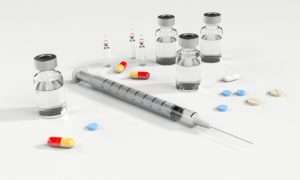Every day, more than 130 people in the United States die after overdosing on opioids1. The misuse of and addiction to opioids—including prescription pain relievers, heroin, and synthetic opioids such as fentanyl—is a serious national crisis that affects public health as well as social and economic welfare. The Centers for Disease Control and Prevention estimates that the total “economic burden” of prescription opioid misuse alone in the United States is $78.5 billion a year, including the costs of healthcare, lost productivity, addiction treatment, and criminal justice involvement.
How did this happen?
In the late 1990s, pharmaceutical companies reassured the medical community that patients would not become addicted to prescription opioid pain relievers, and healthcare providers began to prescribe them at greater rates. This subsequently led to widespread diversion and misuse of these medications before it became clear that these medications could indeed be highly addictive. Opioid overdose rates began to increase. In 2017, more than 47,000 Americans died as a result of an opioid overdose, including prescription opioids, heroin, and illicitly manufactured fentanyl, a powerful synthetic opioid. That same year, an estimated 1.7 million people in the United States suffered from substance use disorders related to prescription opioid pain relievers, and 652,000 suffered from a heroin use disorder (not mutually exclusive).
It’s Worse Than You Think!
Here are some facts about the Opioid Crisis:
- Roughly 21 to 29 percent of patients prescribed opioids for chronic pain misuse them.
- Between 8 and 12 percent develop an opioid use disorder.
- An estimated 4 to 6 percent who misuse prescription opioids transition to heroin.
- About 80 percent of people who use heroin first misused prescription opioids.
- The Midwestern region saw opioid overdoses increase 70 percent from July 2016 through September 2017.
What is Naloxone2?
Naloxone is a medication approved by the Food and Drug Administration (FDA) to prevent overdose by opioids such as heroin, morphine, and oxycodone. It blocks opioid receptor sites, reversing the toxic effects of the overdose. Naloxone is administered when a patient is showing signs of opioid overdose. The medication can be given by intranasal spray, intramuscular (into the muscle), subcutaneous (under the skin), or intravenous injection.
Naloxone is also added to buprenorphine to decrease the likelihood of diversion and misuse of the combination drug product.
A doctor can prescribe naloxone to patients who are in medication-assisted treatment (MAT), especially if the patient is taking medications used in MAT or considered a risk for opioid overdose. Candidates for naloxone are those who:
- Take high doses of opioids for long-term management of chronic pain
- Receive rotating opioid medication regimens
- Have been discharged from emergency medical care following opioid poisoning or intoxication
- Take certain extended-release or long-acting opioid medications
- Are completing mandatory opioid detoxification or abstinence programs

Pregnant women can be safely given naloxone in limited doses under the supervision of a doctor.
A doctor or pharmacist can show patients, their family members, or caregivers how to administer naloxone. An intravenous injection every two to three minutes is recommended in emergencies.
Patients given an automatic injection device or nasal spray should keep the item available at all times. Medication should be replaced when the expiration date passes.
Naloxone is effective if opioids are misused in combination with other sedatives or stimulants. It is not effective in treating overdoses of benzodiazepines or stimulant overdoses involving cocaine and amphetamines.
Side Effects of Naloxone
Patients who experience an allergic reaction from naloxones, such as hives or swelling in the face, lips, or throat, should seek medical help immediately. They should not drive or perform other potentially unsafe tasks.
Use of naloxone may cause symptoms of opioid withdrawal, including:

- Feeling nervous, restless, or irritable
- Body aches
- Dizziness or weakness
- Diarrhea, stomach pain, or nausea
- Fever, chills, or goose bumps
- Sneezing or a runny nose in the absence of a cold
Opioid Overdose
Opioid overdose can happen:
- When a patient misunderstands the directions for use, accidentally takes an extra dose, or deliberately misuses a prescription opioid or an illicit drug like heroin
- If a person takes opioid medications prescribed for someone else
- If a person mixes opioids with other medications, alcohol, or over-the-counter drugs
Opioid overdose is life-threatening and requires immediate emergency attention. Recognizing the signs of opioid overdose is essential to saving lives. Learn more about opioid overdose.
What is Methadone3?

Methadone is a medication used in medication-assisted treatment (MAT) to help people reduce or quit their use of heroin or other opiates. Methadone has been used for decades to treat people who are addicted to heroin and narcotic pain medicines. When taken as prescribed, it is safe and effective. It allows people to recover from their addiction and to reclaim active and meaningful lives. For optimal results, patients should also participate in a comprehensive medication-assisted treatment (MAT) program that includes counseling and social support.
How Does Methadone Work?
Methadone works by changing how the brain and nervous system respond to pain. It lessens the painful symptoms of opiate withdrawal and blocks the euphoric effects of opiate drugs such as heroin, morphine, and codeine, as well as semi-synthetic opioids like oxycodone and hydrocodone.
Methadone is offered in pill, liquid, and wafer forms and is taken once a day. Pain relief from a dose of methadone lasts about four to eight hours. SAMHSA’s TIP 43: Medication-Assisted Treatment for Opioid Addiction in Opioid Treatment Programs – 2008 shows that methadone is effective in higher doses, particularly for heroin users, helping them stay in treatment programs longer.
As with all medications used in medication-assisted treatment (MAT), methadone is to be prescribed as part of a comprehensive treatment plan that includes counseling and participation in social support programs.
How Can a Patient Receive Methadone?
Patients taking methadone to treat opioid addiction must receive the medication under the supervision of a physician. After a period of stability (based on progress and proven, consistent compliance with the medication dosage), patients may be allowed to take methadone at home between program visits. By law, methadone can only be dispensed through an opioid treatment program (OTP)certified by SAMHSA.
The length of time in methadone treatment varies from person to person. According to the National Institute on Drug Abuse publication Principles of Drug Addiction Treatment: A Research-Based Guide – 2012, the length of methadone treatment should be a minimum of 12 months. Some patients may require treatment for years. Even if a patient feels that they are ready to stop methadone treatment, it must be stopped gradually to prevent withdrawal. Such a decision should be supervised by a doctor.
Patients who develop a problem with methadone or have questions can access information through SAMHSA’s Find Help.

Methadone Safety
Methadone can be addictive, so it must be used exactly as prescribed. This is particularly important for patients who are allowed to take methadone at home and aren’t required to take medication under supervision at an OTP. Methadone medication is specifically tailored for the individual patient (as doses are often adjusted and readjusted) and is never to be shared with or given to others. Patients should share their complete health history with health providers to ensure the safe use of the medication.
Other medications may interact with methadone and cause heart conditions. Even after the effects of methadone wear off, the medication’s active ingredients remain in the body for much longer. Taking more methadone can cause an unintentional overdose.
The following tips can help achieve the best treatment results:
- Never use more than the amount prescribed, and always take at the times prescribed. If a dose is missed, or if it feels like it’s not working, do not take an extra dose of methadone.
- Do not consume alcohol while taking methadone.
- Be careful driving or operating machinery on methadone.
- Call 911 if too much methadone is taken or if an overdose is suspected.
- Take steps to prevent children from accidentally taking methadone.
- Store methadone at room temperature and away from light.
- Dispose of unused methadone by flushing it down the toilet.
Learn more from the SAMHSA publication Follow Directions: How to Use Methadone Safely – 2009 (also available in Spanish).
Side Effects of Methadone

Side effects should be taken seriously, as some of them may indicate an emergency. Patients should stop taking methadone and contact a doctor or emergency services right away if they:
- Experience difficulty breathing or shallow breathing
- Feel lightheaded or faint
- Experience hives or a rash; swelling of the face, lips, tongue, or throat
- Feel chest pain
- Experience a fast or pounding heartbeat
- Experience hallucinations or confusion
Pregnant or Breastfeeding Women and Methadone
Women who are pregnant or breastfeeding can safely take methadone. When withdrawal from an abused drug happens to a pregnant woman, it causes the uterus to contract and may bring on miscarriage or premature birth. Methadone’s ability to prevent withdrawal symptoms helps pregnant women better manage their addiction while avoiding health risks to both mother and baby.
Undergoing methadone maintenance treatment while pregnant will not cause birth defects, but some babies may go through withdrawal after birth. This does not mean that the baby is addicted. Infant withdrawal usually begins a few days after birth but may begin two to four weeks after birth.
Mothers taking methadone can still breastfeed. Research has shown that the benefits of breastfeeding outweigh the effect of the small amount of methadone that enters the breast milk. A woman who is thinking of stopping methadone treatment due to breastfeeding or pregnancy concerns should speak with her doctor first.
Learn more from the SAMHSA publication Methadone Treatment for Pregnant Women – 2009.
Training on Providing Methadone
Methadone as an opioid use disorder treatment is carefully regulated. MAT services professionals are required to acquire and maintain certifications to legally dispense and prescribe opioid dependency treatments. SAMHSA’s Division of Pharmacologic Therapies (DPT) makes available opioid prescribing courses for physicians, webinars, workshops, and summits, and publications and research.

What is Buprenorphine4
Buprenorphine is used in medication-assisted treatment (MAT) to help people reduce or quit their use of heroin or other opiates, such as pain relievers like morphine.
Approved for clinical use in October 2002 by the Food and Drug Administration (FDA), buprenorphine represents the latest advance in medication-assisted treatment (MAT). Medications such as buprenorphine, in combination with counseling and behavioral therapies, provide a whole-patient approach to the treatment of opioid dependency. When taken as prescribed, buprenorphine is safe and effective.
Unlike methadone treatment, which must be performed in a highly structured clinic, buprenorphine is the first medication to treat opioid dependency that is permitted to be prescribed or dispensed in physician offices, significantly increasing treatment access. Under the Drug Addiction Treatment Act of 2000 (DATA 2000), qualified U.S. physicians can offer buprenorphine for opioid dependency in various settings, including in an office, community hospital, health department, or correctional facility. Learn more about SAMHSA’s buprenorphine waiver management.
SAMHSA-certified opioid treatment programs (OTPs) also are allowed to offer buprenorphine, but only are permitted to dispense treatment. Learn more about certification of OTPs.
As with all medications used in MAT, buprenorphine is prescribed as part of a comprehensive treatment plan that includes counseling and participation in social support programs.
Buprenorphine offers several benefits to those with opioid dependency and to others for whom treatment in a methadone clinic is not preferred or is less convenient. The FDA has approved the following buprenorphine products:
- Bunavail (buprenorphine and naloxone) buccal film
- Suboxone (buprenorphine and naloxone) film

- Zubsolv (buprenorphine and naloxone) sublingual tablets
- Buprenorphine-containing transmucosal products for opioid dependency
Refer to the product websites for a complete listing of drug interactions, warnings, and precautions.
How Buprenorphine Works
Buprenorphine has unique pharmacological properties that help:
- Lower the potential for misuse
- Diminish the effects of physical dependency to opioids, such as withdrawal symptoms and cravings
- Increase safety in cases of overdose
Buprenorphine is an opioid partial agonist. This means that, like opioids, it produces effects such as euphoria or respiratory depression. With buprenorphine, however, these effects are weaker than those of full drugs such as heroin and methadone.
Buprenorphine’s opioid effects increase with each dose until at moderate doses they level off, even with further dose increases. This “ceiling effect” lowers the risk of misuse, dependency, and side effects. Also, because of buprenorphine’s long-acting agent, many patients may not have to take it every day.
Side Effects of Buprenorphine
Buprenorphine’s side effects are similar to those of opioids and can include:
- Nausea, vomiting, and constipation
- Muscle aches and cramps
- Cravings
- Inability to sleep
- Distress and irritability
- Fever
Buprenorphine Misuse Potential
Because of buprenorphine’s opioid effects, it can be misused, particularly by people who do not have an opioid dependency. Naloxone is added to buprenorphine to decrease the likelihood of diversion and misuse of the combination drug product. When these products are taken as sublingual tablets, buprenorphine’s opioid effects dominate, and naloxone blocks opioid withdrawals. If the sublingual tablets are crushed and injected, however, the naloxone effect dominates and can bring on opioid withdrawals.

Buprenorphine Safety
People should use the following precautions when taking buprenorphine:
- Do not take other medications without first consulting your doctor.
- Do not use illegal drugs, drink alcohol, or take sedatives, tranquilizers, or other drugs that slow breathing. Mixing large amounts of other medications with buprenorphine can lead to overdose or death.
- Do ensure that a physician monitors any liver-related health issues that you may have.
Pregnant or Breastfeeding Women and Buprenorphine
Limited information exists on the use of buprenorphine in women who are pregnant and have an opioid dependency. But the few case reports available have not demonstrated any significant problems resulting from the use of buprenorphine during pregnancy. The FDA classifies buprenorphine products as Pregnancy Category C medications, indicating that the risk of adverse effects has not been ruled out.
Review SAMHSA’s TIP 40: Clinical Guidelines for the Use of Buprenorphine in the Treatment of Opioid Addiction – 2004and Federal Guidelines for Opioid Treatment Programs – 2015 for more information about the use of buprenorphine in pregnancy. In the United States, methadone remains the current standard of care for the use of MAT with pregnant women who have an opioid dependency.
Treatment with Buprenorphine
The ideal candidates for opioid dependency treatment with buprenorphine:
- Have been objectively diagnosed with an opioid dependency
- Are willing to follow safety precautions for the treatment
- Have been cleared of any health conflicts with using buprenorphine
- Have reviewed other treatment options before agreeing to buprenorphine treatment.

Before buprenorphine treatment begins, policies and procedures should be in place to guarantee patient privacy and the confidentiality of personally identifiable health information. Under the Confidentiality Regulation, 42 Code of Federal Regulations (CFR) 2, information relating to substance use and alcohol treatment must be handled with a higher degree of confidentiality than other medical information.
Buprenorphine treatment happens in three phases:
- The Induction Phase is the medically monitored startup of buprenorphine treatment performed in a qualified physician’s office or certified OTP using approved buprenorphine products. The medication is administered when a person with an opioid dependency has abstained from using opioids for 12 to 24 hours and is in the early stages of opioid withdrawal. It is important to note that buprenorphine can bring on acute withdrawal for patents who are not in the early stages of withdrawal and who have other opioids in their bloodstream.
- The Stabilization Phase begins after a patient has discontinued or greatly reduced their misuse of the problem drug, no longer has cravings, and experiences few, if any, side effects. The buprenorphine dose may need to be adjusted during this phase. Because of the long-acting agent of buprenorphine, once patients have been stabilized, they can sometimes switch to alternate-day dosing instead of dosing every day.
- The Maintenance Phase occurs when a patient is doing well on a steady dose of buprenorphine. The length of time of the maintenance phase is tailored to each patient and could be indefinite. Once an individual is stabilized, an alternative approach would be to go into a medically supervised withdrawal, which makes the transition from a physically dependent state smoother. People then can engage in further rehabilitation—with or without MAT—to prevent a possible relapse.
Treatment of opioid dependency with buprenorphine is most effective in combination with counseling services, which can include different forms of behavioral therapy and self-help programs. Learn more about medication and counseling treatment.
Switch from Methadone to Buprenorphine
Patients can switch from methadone to buprenorphine treatment, but because the two medications are so different, patients may not always be satisfied with the results. Studies in

A number of factors affect whether buprenorphine is a good choice for someone who is currently receiving methadone. Patients receiving buprenorphine can possibly be switched to methadone. Patients interested in learning more about switching their treatment should discuss this with their doctor. Learn more about methadone.
Is the Opioid Crisis Accelerating?
Maybe. The National Institute on Drug Abuse states that:
- Opioid overdoses increased 30 percent from July 2016 through September 2017 in 52 areas in 45 states.
- Opioid overdoses in large cities increased by 54 percent in 16 states.
Jay Harold provides relevant and practical knowledge for your life, your health, and your wealth. ”This post, “Opioid Crisis: 3 Medications to Prevent Overdose” is part of that effort to make you a more knowledgeable healthcare person. Please Share it and read more about Jay Harold here. Please take this advice from Muhammad Ali and give back to others. “Service to others is the rent you pay for your room here on earth.




